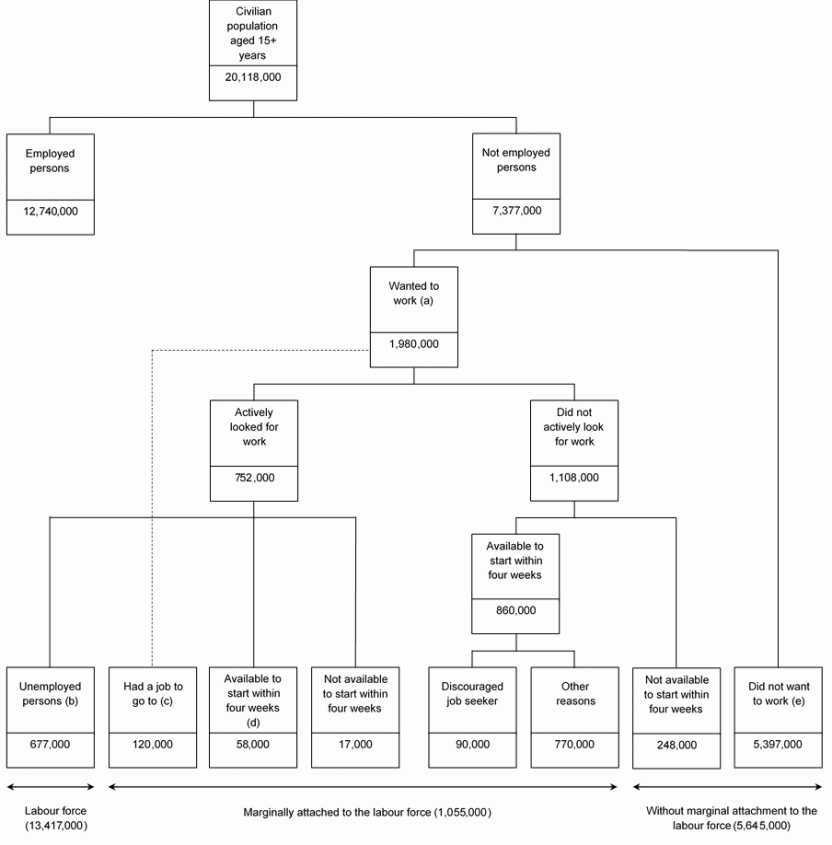Seeking more hours
12.7 million people were employed in February 2019, which is almost two-thirds of the civilian population aged 15 and over (20.1 million). Of these, around 1.1 million people (9% of employed) were underemployed, almost all of whom usually work part time (1.0 million). Underemployment has been reasonably stable in the past few years (1.0 million people in February 2015), but has grown over the past decade (from 0.5 million people in February 2008).
45.9% of underemployed part-time workers in February 2019 had been underemployed a year or more. If a suitable job was offered, 16.8% would be prepared to move interstate, and 22.6% would be prepared to move intrastate.
Just under half (49.6%) of underemployed part-time workers took active steps to look for additional hours.
More information about underemployment and preference for more hours for 2015 to 2019 can be found in Tables 2-7 in the Data downloads section.
Job mobility
8.5% (1.1 million) of employed persons changed employers or businesses in the twelve months up to February 2019. This continues a trend of increasing job churn compared with the past few years, with 7.9% (0.9 million) changing employers or businesses in the year to February 2015. The recent increase is driven largely by an increase in mobility for professionals. Overall levels of job churn are still relatively low compared to a decade ago (over 1.2 million persons changed job in the 12 months ending February 2008).
More information about labour mobility for 2015 to 2019 can be found in Tables 17-20 in the Data downloads section.
Seeking a job
Of the 677,000 unemployed persons in February 2019, 87.8% reported having difficulty finding work.
Reasons for difficulty finding work have changed somewhat in recent years, with an increase since February 2015 in personal factors such as “Insufficient work experience” and “Own ill health or disability”, and a decrease in job related factors such as “Too many applicants” and “No vacancies at all”.
More information about job search experience of unemployed persons for 2015 to 2019 can be found in Tables 12-16 in the Data downloads section.
Potential to join the labour force
Of the 6.7 million persons not in the labour force (NILF) at February 2019, 1.1 million (15.7%) were marginally attached, as they wanted to work, and were either available to start work, or had actively looked for work. Persons marginally attached have decreased from 17.1% of NILF at February 2015, following a similar downward trend as unemployed persons in the same period.
Image

Description
- Includes people who 'Might want to work'
- Includes people who had a job to go to and could have started in the reference week - 'Future starters'.
- Refers to people who had a job to go to, but were not available to start in the reference week.
- Refers to people who were not available to start in the reference week.
- Includes people who are permanently unable to work and those who 'Did not know'.
Another 5.6 million persons are not in the labour force and not marginally attached. They either:
- did not want to work (4.8 million or 72.2% of NILF),
- permanently unable to work (560,000 or 8.4%), or
- wanted to work but were neither actively looking nor available to start within four weeks (250,000 or 3.7%).
The increase of those who did not want to work, up from 4.5 million (69.6% of NILF) in February 2015, is almost entirely driven by retirees.
More information about participation potential and marginal attachment for 2015 to 2019 can be found in Table 1 and Tables 8-11 in the Data downloads section.
Further information
For more information on these on any other labour statistics, contact the ABS Labour Statistics branch via labour.statistics@abs.gov.au.

